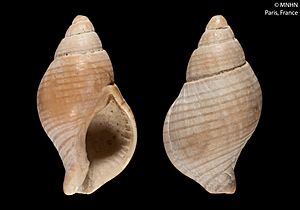Lined whelk facts for kids
Quick facts for kids Lined whelk |
|
|---|---|
 |
|
| Shell of Buccinulum linea (lectotype at MNHN, Paris) | |
| Scientific classification | |
| Kingdom: | |
| Phylum: | |
| Class: | |
| (unranked): |
clade Caenogastropoda
clade Hypsogastropoda clade Neogastropoda |
| Superfamily: |
Buccinoidea
|
| Family: | |
| Subfamily: | |
| Tribe: |
Buccinulini
|
| Genus: |
Buccinulum
|
| Species: |
B. linea
|
| Subspecies: |
B. linea linea
|
| Trinomial name | |
| Buccinulum linea linea (Martyn, 1784)
|
|
| Synonyms | |
|
|
The lined whelk, known scientifically as Buccinulum linea linea, is a type of sea snail. It is a mollusc that belongs to the group called gastropods. This means it has a single shell and moves on a muscular "foot."
This particular whelk is a subspecies of Buccinulum linea. It lives in the ocean and is part of the Buccinidae family, which includes many different kinds of whelks. You can only find the lined whelk in New Zealand, including the Chatham Islands.
Contents
What is a Whelk?
A whelk is a kind of sea snail. Most whelks have a spiral shell that is often cone-shaped or oval. They are carnivores, meaning they eat other animals. Whelks usually live on the seafloor. They can be found in many different ocean environments.
Where Does the Lined Whelk Live?
The lined whelk, Buccinulum linea linea, is special because it is endemic to New Zealand. This means it is found naturally only in New Zealand waters. It lives in the ocean around the main islands of New Zealand. It also lives near the Chatham Islands, which are a group of islands east of New Zealand.
What Does the Lined Whelk Look Like?
Like other whelks, the lined whelk has a strong, spiral shell. The shell helps protect its soft body. The name "lined whelk" suggests that its shell might have distinct lines or patterns. These patterns can help it blend in with its surroundings. The exact size and color can vary.
Its Scientific Name
The full scientific name for the lined whelk is Buccinulum linea linea. This name helps scientists around the world know exactly which animal they are talking about. The first part, Buccinulum, is the genus. The second part, linea, is the species. The third part, linea again, shows it is a specific subspecies.
The name was first given by Martyn in 1784. This date tells us when it was first officially described by scientists.
See also
 In Spanish: Buccinulum linea linea para niños
In Spanish: Buccinulum linea linea para niños

